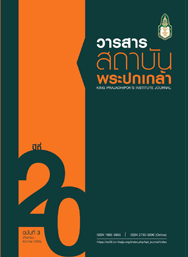Innovations in the Chinese Political System
Main Article Content
Abstract
Over the past 40 years, China has successfully been upgraded and achieved in its development. It was substantially changed from a country of backwardness and having no meaningful role to play in world’s affairs to the one that of advance in economy and technology, and having vital roles in the international stage. The success of China’s development was the result of Deng Xiaoping’s reform and opening-up policy started in 1978. Background of the successful story was largely due to the six innovative elements in the political system that directed the society and laid down a solid foundation for the development. They include: 1) the political system; 2) the economic system; 3) the party system; 4) the electoral system; 5) the size of the representative bodies; and 6) the political consultative system. Interestingly, these factors are neither in line with the principles practiced in liberal democratic countries nor the standard curriculum taught in colleges and universities at large.
Article Details

This work is licensed under a Creative Commons Attribution-NonCommercial-NoDerivatives 4.0 International License.
@ 2020 King Prajadhipok's Institute The Government Complex Commemorating All Right Reserved.
References
ภาษาไทย
ข้อความในจดหมายที่เหมาเจ๋อตุงส่งถึงหลินเปียวในเดือนเมษายน ค.ศ. 1930. (ม.ป.ป.). สืบค้นจาก http://www.moj.gov.cn>dszl>dsbk
คณะกรรมาธิการประจำของสภาผู้แทนประชาชนนครเซินเจิ้น ชุดที่ 7. (ม.ป.ป.). สืบค้นจากhttp://zh.wikipedia.org/zh-hk
คณะกรรมาธิการประจำของสภาผู้แทนประชาชนมณฑลกวางตุ้ง ชุดที่ 13. (ม.ป.ป.). สืบค้นจาก http://www.rd.gd.cn
คณะกรรมาธิการประจำของสภาผู้แทนประชาชนแห่งชาติชุดที่ 13. (ม.ป.ป.). (สืบค้นจาก https://www.gov.cn
ทวีป วรดิลก. (2547). ประวัติศาสตร์จีน. (พิมพ์ครั้งที่ 4). กรุงเทพฯ: สุขภาพใจ.
นครินทร์ ศรีเลิศ. (2557, 30 กรกฎาคม). อวสานสภาที่ปรึกษาฯ บทเรียนลอกแบบตะวันตก. กรุงเทพธุรกิจ. สืบค้นจาก https://www.bangkokbiznews.com/politics/596019
นิยม รัฐอมฤต และคณะ. (2520). การปกครองท้องถิ่นเปรียบเทียบ. กรุงเทพฯ: มหาวิทยาลัยรามคำแหง
ผลการสำรวจความเห็นของชาวจีนชี้คะแนนนิยมรัฐบาลพุ่งทะลุ 90 เปอร์เซ็นต์. (2565). สืบค้นจาก https://www.infoquest.co.th/2022/166573
พรรคคอมมิวนิสต์แห่งประเทศจีนมีสมาชิก จำนวน 95,148,000 คนเศษ (ข้อมูล 5 มิถุนายน 2564 : เลขาธิการใหญ่พรรคคือ สีจิ้นผิง. (2564). สืบค้นจาก https;//zh.m.wikipedia.org>wiki
พระราชบัญญัติสภาที่ปรึกษาเศรษฐกิจและสังคมแห่งชาติ พ.ศ. 2543. (2543, 19 ธันวาคม). ราชกิจจานุเบกษา. เล่ม 117 ตอนที่ 118 ก. น. 1-11.
รัฐธรรมนูญแห่งราชอาณาจักรไทย พ.ศ. 2540. (2540, 11 ตุลาคม). ราชกิจจานุเบกษา. เล่ม 114 ตอนที่ 55 ก. น. 1-99.
รัฐธรรมนูญแห่งราชอาณาจักรไทย พ.ศ. 2550. (2550, 24 สิงหาคม). ราชกิจจานุเบกษา. เล่ม 124 ตอนที่ 47 ก. น. 1-127.
วิบูลย์ ตั้งกิตติภาภรณ์. (2554). ถอดรหัสลับยุทธศาสตร์จีน. สมุทรปราการ: โครงการสำนักพิมพ์มหาวิทยาลัยหัวเฉียวเฉลิมพระเกียรติ
สมบูรณ์ สุขสำราญ. (2551). ประชาธิปไตยระบบรัฐสภาแบบอังกฤษ. นนทบุรี: สถาบันพระปกเกล้า.
อุดม รัฐอมฤต และนิยม รัฐอมฤต. (2558). กฎหมายรัฐธรรมนูญจีน. กรุงเทพฯ: วิญญูชน.
ภาษาจีน
陈振江, 江沛. (2003).《中国历史;晚清民国卷》. 北京:高等教育出版社.
黑雁男. (1988). 《十年动乱》. 香港:星辰出版社.
旷晨, 潘良. (2006). 《我们的1980年代》(Our Times 1980s). 北京:中国友谊出版公司.
邵维正. (2000).《中国共产党80年:大事聚焦》. 北京:解放军出版社.
吴爱明, 朱国斌, 林震. (2010). 《当代中国政府与政治》. 修订版), 北京:中国人民大学出版社.。
杨继绳. (1998).《邓小平时代:中国改革开放纪实》. 北京:中央编译出版社.
周明伟和其他人. (2016). 《中国关键词:权威解读当代中国》 (Keywords to Understand China). 北京:新世界出版 社.
广东政协网. (n.d.). Retrieved from http://gdszx.gov.cn
新一届广州市政协委员名单公布. (n.d.). Retrieved from https;//m.sohu.com
中国人民政治协商会议第十三届全国委员会委员名单2020/05/11中国政协网. (2020). Retrieved from http://www.cppcc.gov.cn
中国人民政治协商会议深圳市委员会-维基百度. (n.d.). Retrieved from https;//zn.m.wikipedia.org>zh-hans
中国人民政治协商会第十三届常务委员会. Retrieved from https://zh.wikipedia.org
中国共产党章程 (ข้อบังคับพรรคคอมมิวนิสต์แห่งประเทศจีน). (2004). 北京:人民出版社.
中华人民共和国宪法 (รัฐธรรมนูญแห่งสาธารณรัฐประชาชนจีน). (2004). 北京:中国民主法制出版社.
中华人民共和国地方各级人民代表大会和地方各级人民政府组织法 (กฎหมายว่าด้วยการจัดตั้งสภาผู้แทนประชาชนท้องถิ่นทุกระดับและรัฐบาลท้องถิ่นทุกระดับ). (2000). 北京:法律出版社.
中华人民共和国全国人民代表大会和地方各级人民代表大会选举法 (กฎหมายว่าด้วยการเลือกตั้งสมาชิกสภาผู้แทนประชาชนแห่งชาติและสมาชิกสภาท้องถิ่นทุกระดับ). (2000). 北京:法律出版社.
中国共产党第十九次全国代表大会文件汇编. (2017). 北京:人民出版社.
ภาษาอังกฤษ
Bingham, Richard D. & Hedge, David. (1991). The State and Local Government in a Changing Society. New York: McGraw-Hill.
China-Youth Literacy Rate. (n.d.). Retrieved from https://knoema.com/atlas/
China/topics/Education/Literacy/Youth-literacy-rate
Economy of China. (n.d.). Retrieved from https://en.wikipedia.org
Fung, Archon & Wright, Erik Olin. (2003). Thinking About Empowered Participatory Governance. In Archon Fung & Erik Olin Wright (Eds.), Deepening Democracy. London: Verso.
General Office of the CPPCC National Committee. (ed.). (2003). The Chines People’s Political Consultative Conference – A Brief Introduction. Beijing: The CPPCC.
Hague, R., Harrop, M. & McCormick, J. (1998). Comparative Government and Politics: An Introduction. (4th edition.). Houndmills, Basingstoke, Hampshire: Macmillan.
Huang, Chengwei. (2015). China’s Poverty Alleviation Operations. Beijing: China International Press.
Lee, Bandy X. (n.d.). The Dangerous case of Donald Trump, 2022. Retrieved from
Morgan, Richard E. et al. (1979). American Politics: Directions of Change, Dynamics of Choice. Reading, Massachusetts: Addison-Wesley.
Occupy Wall Street. (n.d.). Retrieved from https://en.m.wikipedia.org>wiki
Parenti, Michael. (1974). Democracy for the Few. New York: St. Martin’s Press.
Stiglitz, Joseph. (2011). Of the 1%, By the 1%, the 1%. Retrieved from https://www.vanityfair.com/news/2011/05/top-one-percent-201105
Stoessinger, John G. (1990). Nations in Darkness: China, Russia, and America. (5th edition). New York: McGraw-Hill.
The editorial staff. (2019). 70 Keywords for 70 years (1949-2019). Chicago: Phoenix Tree Publishing.
Why did people vote for Donald Trump? Voters explain. (2016). Retrieved from https://www.theguardian.com/us-news/2016/nov/09/why-did-people-vote-for-donald-trump-us-voters-explain
Zhang Yun. (2012). The Logic of the Weak in International Relations: ASEAN’s External Relations with Major Powers in the Asia-Pacific Region. Nagoya City, Japan: V2 Solution Publisher.


